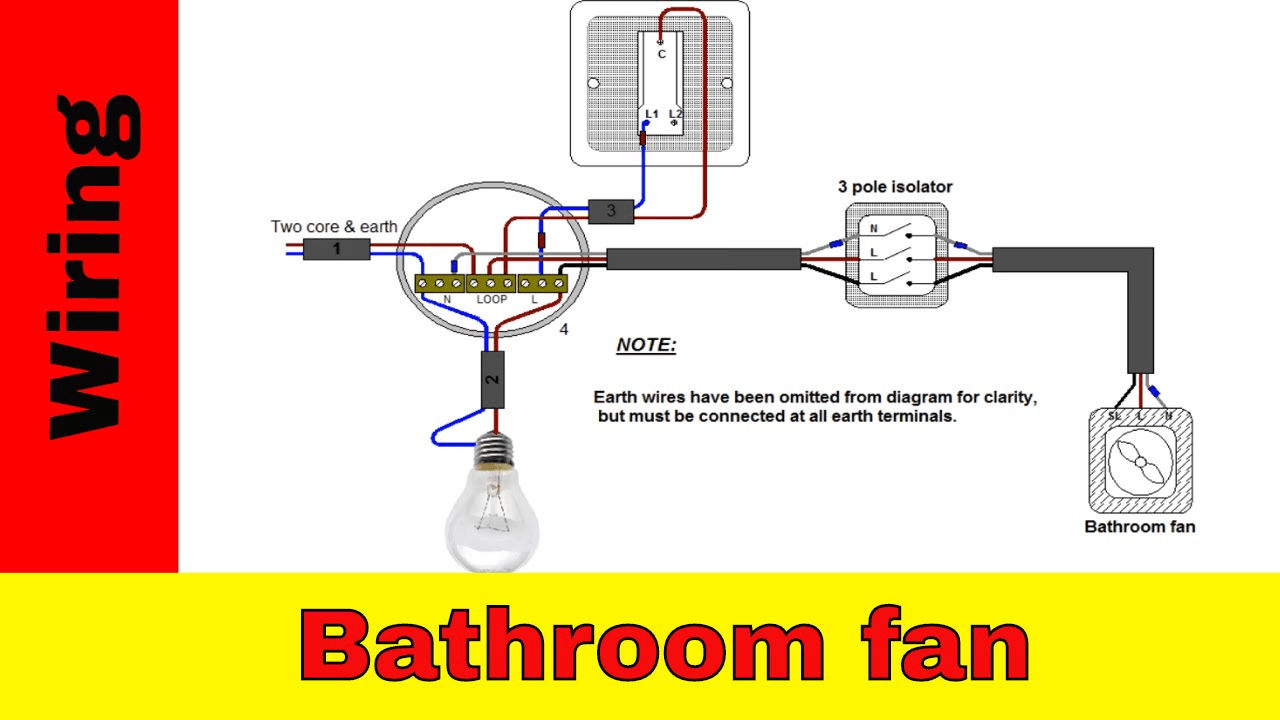Electrical Wiring for Bathroom Light and Fan

Wiring for bathroom light and fan – When it comes to home improvement, there are certain tasks that are best left to the professionals. Electrical wiring is one of those tasks. However, if you’re feeling confident and have a good understanding of basic electrical principles, you may be able to tackle the job yourself.
In this article, we’ll provide you with a step-by-step guide on how to wire a bathroom light and fan. We’ll also discuss the different types of electrical wires used for bathroom lighting and fan installations.
Safety Precautions
- Before you begin any electrical work, it’s important to take some safety precautions.
- Make sure that the power to the circuit you’re working on is turned off at the breaker panel.
- Wear rubber gloves and safety glasses to protect yourself from electrical shock and flying debris.
- Use a voltage tester to make sure that the circuit is actually dead before you begin working.
Electrical Wiring Diagram
The basic electrical wiring diagram for connecting a bathroom light and fan to a power source is shown below.

Wiring a bathroom light and fan is a simple task that can be completed in a few hours. First, you’ll need to turn off the power to the bathroom at the breaker box. Next, you’ll need to remove the old light fixture and fan.
Once the old fixtures are removed, you can install the new light fixture and fan. Be sure to follow the manufacturer’s instructions for installation. Once the new fixtures are installed, you can turn the power back on at the breaker box.
And voila! You’ll have a new light and fan in your bathroom. Oh, and if you’re looking for a cool way to decorate your bathroom, check out this mac miller wallpaper. It’s sure to add some style to your bathroom.
As you can see, the light and fan are both connected to the same power source. The light is connected to the black wire, and the fan is connected to the red wire. The white wire is the neutral wire, and the green wire is the ground wire.
Step-by-Step Guide
- Once you have the electrical wiring diagram in mind, you can begin the wiring process.
- Start by connecting the black wire from the light to the black wire from the power source.
- Next, connect the red wire from the fan to the red wire from the power source.
- Then, connect the white wire from the light to the white wire from the power source.
- Finally, connect the green wire from the light to the green wire from the power source.
Types of Electrical Wires, Wiring for bathroom light and fan
There are a few different types of electrical wires that can be used for bathroom lighting and fan installations.
- Romex is a type of non-metallic cable that is commonly used for residential electrical wiring.
- BX cable is a type of armored cable that is often used in commercial and industrial applications.
- Conduit is a type of metal pipe that is used to protect electrical wires from damage.
The type of electrical wire that you use will depend on the specific requirements of your installation.
Wiring for bathroom light and fan is a crucial task that requires attention to detail. However, if you encounter a burning smell coming from your bathroom exhaust fan, it’s important to investigate further. Check out this article on bathroom exhaust fan burning smell for expert advice on identifying and resolving the issue.
Once the burning smell is addressed, you can return to your wiring project for the bathroom light and fan, ensuring a safe and functional bathroom space.
Troubleshooting Bathroom Light and Fan Wiring Issues

Wiring issues in bathroom lights and fans are common electrical problems that can be frustrating to deal with. However, with a little troubleshooting, you can often fix these problems yourself.
One of the most common problems is a loose connection. This can happen over time as the wires vibrate or are jostled. To fix a loose connection, simply tighten the screws that hold the wires in place.
Another common problem is a blown fuse or tripped circuit breaker. This can happen if there is a power surge or if too much electricity is drawn through the circuit. To fix this problem, simply replace the fuse or reset the circuit breaker.
If you are having trouble troubleshooting the problem yourself, you may need to call an electrician. An electrician can diagnose the problem and make the necessary repairs.
Here are some tips to help prevent electrical problems with bathroom light and fan wiring:
– Make sure that all connections are tight.
– Use the correct size wire for the amperage of the circuit.
– Do not overload circuits.
– Have your electrical system inspected regularly by a qualified electrician.
Safety Considerations for Bathroom Light and Fan Wiring

When wiring bathroom lights and fans, it’s paramount to adhere to electrical codes and safety regulations. Neglecting these guidelines can lead to hazardous situations and potential electrical accidents.
Improper wiring can result in electrical shocks, fires, and even electrocution. These accidents can have severe consequences, causing injury, property damage, and even loss of life.
Personal Protective Equipment (PPE)
Working with electricity requires proper personal protective equipment (PPE) to minimize the risk of accidents. This includes:
- Insulated gloves
- Safety glasses
- Non-conductive footwear
- Hard hat (in certain situations)